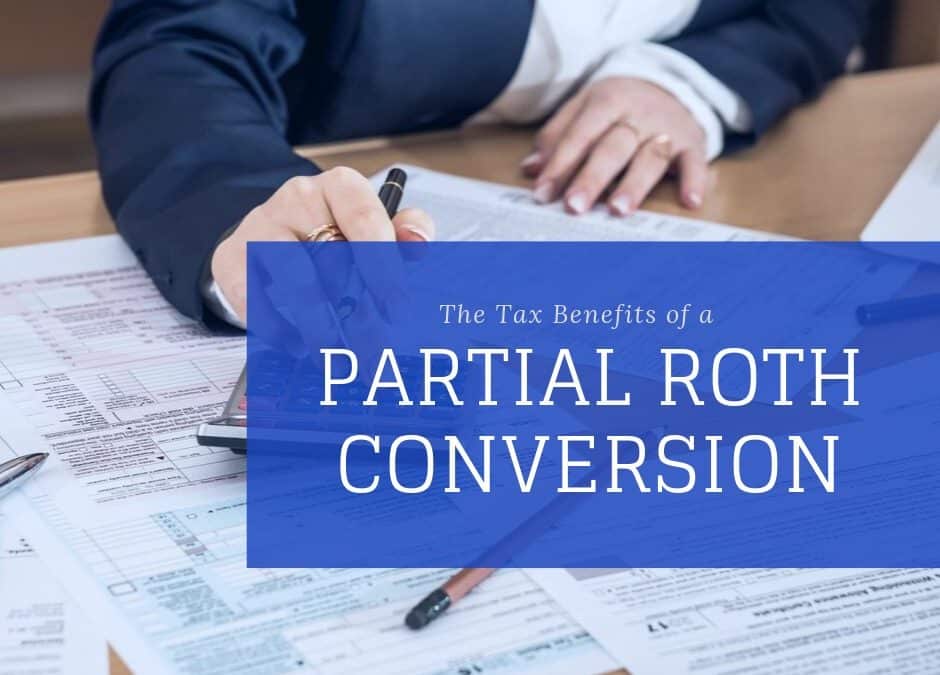It always hits our clients at some point after age 50. Retirement is no longer a mirage off in the distance—it’s a real event that’s coming into sharper focus. With that clarity comes new questions about turning retirement savings into retirement income.
The decade or so before retirement is critical because it’s your best chance to manage taxes now and in the future, particularly when required minimum distributions (RMDs) kick in at age 72. If you’ve saved a lot in an IRA, then you’re going to have to take big RMDs and, potentially, pay high taxes on those withdrawals.
The reality, of course, is that we all pay taxes. But you shouldn’t pay any more than necessary.
That’s why I often suggest transferring some of your traditional IRA savings into a Roth IRA with a Roth conversion.
With a Roth conversion, you move money out of your traditional IRA, pay the taxes on it upfront, and have a new source of tax-free retirement income.
A common misconception, however, is that a Roth IRA conversion is all or nothing. But, in fact, you can convert smaller amounts over several years. And when you get the timing and size of those conversions right, you can stay within your current tax bracket while reducing the size of your traditional IRA and future RMDs.
Essentially, you’re making smaller tax payments over time—rather paying than a boatload of taxes later in retirement—and, hopefully, less taxes overall.
The Ideal Roth Conversion Scenario
The biggest benefit from a partial Roth conversion comes when your current tax rate is lower than your expected tax rate will be when RMDs kick in at age 72. In those cases, you can calculate the exact amount of IRA assets you can afford to convert each year while staying within your current, relatively low tax bracket.
For many of our clients who choose to retire in their 60s, we find the sweet spot for partial Roth conversions is in the years after retirement and up to age 72.
Consider a couple who retire at age 65 with a $3 million portfolio, $1 million of which is saved in a traditional IRA. Their joint income has dropped from the $250,000 they were earning before retirement to about $50,000 mostly taken income on their taxable investments—dropping them into the 12% tax bracket.
This lower income bracket gives the couple a lot of headroom to convert savings from their traditional IRA without increasing their current tax bracket, so they might decide to convert $27,000 each year for seven years to reduce their IRA balance by $189,000. This helps reduce the couple’s RMDs and related taxable income they must realize after age 72.
In this particular example, someone may determine they will move beyond the 22% tax bracket and into the 24% tax bracket once they start receiving Social Security benefits. In this situation, a case can be made for converting a larger portion of your IRA and move into a higher tax bracket today, but still remain at a lower bracket than where you expect to be at the point you are taking RMDs.
Other Ways to Make It Work
If you are not able to take advantage of the years between retirement and age 72 to perform such super-charged Roth conversions, there are other ways to get similar benefits. But what works for you will depend greatly on your own circumstances.
For example, you might stretch a partial conversion out over a longer period—say, from age 60 to age 72. This approach could allow you to convert smaller sums each year, keeping your annual income within your existing tax bracket and still removing a big chunk from your traditional IRA by the time RMDs kick in.
You also might be able to use tax deductions to offset the cost of a given year’s conversion.
A good example of this is using a donor-advised fund to maximize the tax benefit of your charitable donations while also reducing the cost of a partial Roth conversion. For business owners, accelerating expenses or delaying income into a specific calendar year can also help manage the taxes associated with a partial Roth conversion.
For many people, a partial Roth conversion helps make sure you don’t overpay the government—while reducing the chance of a nasty surprise like a staggering tax bill after age 72.
Next Steps…
A partial Roth conversion is just one strategy I can offer to help you maximize how you use your money. There are dozens of strategies you can use at any point in your finance journey – before or after retirement.
If you would like to hear more about how I can help you, book a quick 15-minute call with me.
You may also enjoy the free worksheets and checklists I have that will help you make smart financial decisions like deciding if you should rent or buy a house, determine your net worth, or figure out how much cash flow you have every month.
Additional posts to read for more retirement tips include:
- How an HSA Can Boost Your Retirement Savings
- The Most Important Rule In Planning For Retirement
- The Most Potent Combination For Wealth Creation
RESOURCE: Do you want to make smart decisions with your money? Discover your biggest opportunities in just 9 questions with my Financial Wellness Assessment.

This post first appeared on WallStreetJournal.com















I am 65 years old and plan to make Roth conversions at least until I am 70 years old up to the $320,000 level. (IRMA bracket) This is based on my own analysis. I am looking for someone to confirm this strategy. I made my first large conversion in 2018 and plan to make the second before 2019 ends. Can you help with this?
Hi Jeff, thanks for reading! Feel free to navigate to my Work With Me page and we can set up time for me to discuss.
Peter, thank you putting this information out to the public. I am 62 and just retired and trying to do some calculations on my own. I am finding that although the tax bills for the RMD’s will be reduced starting at age 72, the overall present value benefit of doing the conversions is better than not converting only if I live beyond age 80. That seems to be because the present value of the tax bills I pay in the next 10 years (even at lower rates than anticipated at age 72) combined with the present value hit to the taxable account to pay the taxes takes a while to overcome. Although I haven’t given all the particulars here, does this general conclusion seem about right to you? Thank you!
Hi Mark. Thanks for reading. I can’t give specific advice on this platform, but I can say that the conversions still make a lot of sense to me despite RMDs now beginning at age 72. The way I see it, if you live to your early 80s as the average life expectancy would suggest, then this remains a very useful strategy assuming you don’t put yourself in a top tax bracket due to the process of conversion.